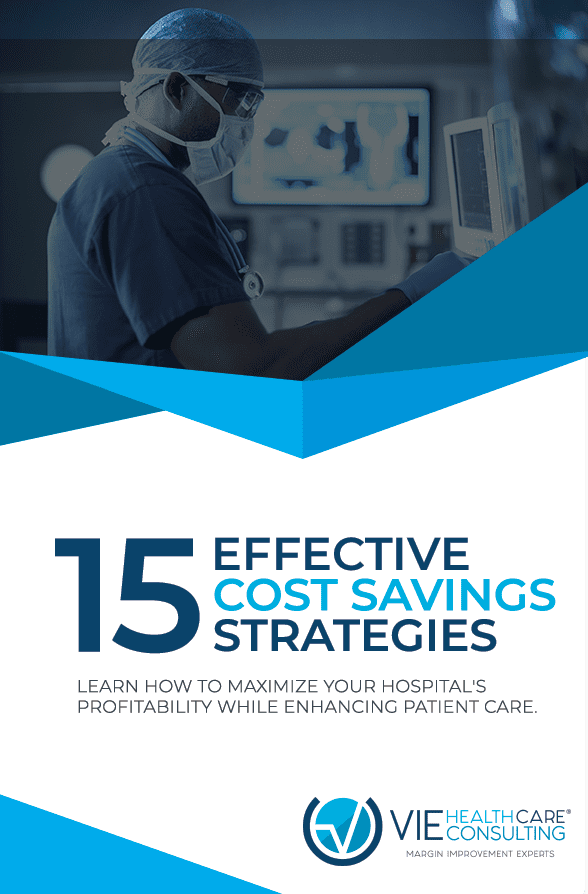Outsourcing, Insourcing, or ‘Right-sourcing’
This article was written by Lisa Miller.
The healthcare sector relies heavily on outsourcing purchased services – but when should your hospital bring outsourced services in-house?
We live in a time where outsourcing services has become the norm, even for our everyday experiences.
Without leaving the comfort of our couch, we can pay someone to perform tasks that we used to do ourselves. From cleaning our homes, walking the dog and doing laundry to grocery shopping and driving us to the airport, as a society we have perfected the art of outsourcing.
More traditionally, we can pay someone else to change the oil in our car and provide lawn care for our homes.
While outsourcing these responsibilities can make life simpler and more efficient, they come with a price tag. The payer also may become dissatisfied with the services for which they are paying.
Outsourcing, Insourcing, or ‘Right-sourcing’

Now consider the purchased services in your hospital. Hospitals have been outsourcing services since the turn of the 20th century and this has now become the norm for the typical US hospital.
A cultural belief exists that certain products or services within a hospital should be outsourced. Justifying it with “we have always done it this way” further reinforces this mindset but in some cases those services could be performed better in-house at a lower cost.
‘Right-sourcing’
The idea of ‘right-sourcing’ is a term that has been used since the early 2000’s and has gained popularity in healthcare. It simply means choosing the correct source.
There is no ‘one size fits all’ approach.
As healthcare organizations merge and grow, the strategy used to determine which services should be outsourced and which should be performed in-house may need to change.
Each health system must adopt a strategic process to develop a balanced approach to outsourcing versus insourcing that fits their specific needs.
Obstacles to Insourcing
When considering the shift from outsourcing to insourcing, some of the most common obstacles are:
- Getting your health system decision-makers to see and understand the potential savings opportunities within purchased services. This is often the biggest obstacle to overcome.
- Health leaders are now beginning to prioritize their purchased services, but this is often hindered by a lack of resources and the other myriad responsibilities they must juggle each day.
- The challenge of gaining commitment from decision-makers to devote time and resources to all purchased services is exacerbated as potential cost savings are not as obvious or immediate for non-clinical spending categories as they are for clinical (e.g. high-cost OR items/implants).
- Clinicians and frontline employees are often resistant to moving towards insourcing, especially if a product or service has been outsourced for a long time. Pushback should also be expected when clinicians discover they will have to adjust to a new way of doing things.
- Purchased services is often managed by individual hospitals within a system or even at the department level. When the outsourced services have not been implemented and managed by the entire health system, there is less standardization, less negotiating expertise, less buying power and fewer resources to try to accomplish what needs to be accomplished. The fragmented and decentralized nature of this approach often means vendor performance and cost has not been evaluated as often as it should have been.
How Do We Prepare for Insourcing?
At VIE Healthcare Consulting, we recommend the following steps:
Step one: Create a value analysis team
This team should include department heads and frontline employees involved in decision-making to minimize pushback and encourage buy-in on implementation. In particular, employees directly impacted by a change should be invited to contribute to the decision.
Additionally, department heads and clinical staff should report to and liaise with a supply chain executive who has experience in analyzing data and negotiating contracts.
An individual with a background in contracting services should be an integral part of this value analysis team, but also needs to work with those involved in direct patient care.

Step two: Rely on performance-based contracts with your vendors
These are also known as shared-risk or shared-benefit contracts.
Simply establishing performance-based contracts with multiple vendors is not enough. Your organization must monitor performance and provide feedback to the vendor to ensure the services and products are being delivered as defined in the contract.
If the vendor is not meeting their contractual obligations it may be time to look for another vendor or bring those services in-house.
Step three: Create coterminous vendor contracts
For larger health systems, a third option is to make vendor contracts at different facilities coterminous. This will help your health system to manage and analyze all contracts more effectively.
With contracts expiring at the same time, a value analysis team can more easily negotiate better pricing and services – or determine if it is time to insource certain services.
This answers the question of when is a good time to bring outsourced services in-house.
It is much easier for a hospital to insource a purchased service at the end of a contract rather than in the middle of it. Click To Tweet
Lastly, it goes without saying that change is difficult.
Hospital leaders and department heads may ‘drag their feet’ on learning they must leave the vendor that has been providing services for many years. In many cases, those directly responsible for the conversion have held long-term business relationships with their vendors.
In this situation, delaying the change would not only help their friend financially, but also avoid the disruption that any change brings to a department.
This brings us back to the importance of ensuring that everyone directly affected by insourcing is included in the conversation and their concerns addressed.
7 Simple Questions to Determine if it is Time to Bring Services In-House
Making the decision to bring services in-house is a complex one and often difficult to navigate.
To simplify and clarify the process, at VIE Healthcare we suggest that hospital decision-makers ask very specific questions. These include:
- Is the vendor providing what they have been contracted to provide?
- Are the vendor’s services being delivered as advertised?
- Can we perform these services at or above the current standard or quality?
- Can we perform these services at a lower cost?
- Are any of the vendor’s services, behaviors or tendencies negatively impacting patient care?
- Are the outsourced services being provided in a way that lines up with our organization’s mission and values?
- Are we willing to take on the risk involved with specific services that are currently being outsourced?
The decision to bring an outsourced service in-house is more than just a financial one. Hospital leaders must consider all aspects of the services being outsourced and whether or not the benefits outweigh the risks.
Staffing, funding, or liability issues may lead a hospital or health system to decide to continue outsourcing a particular service.
Another factor to consider is using national versus local vendors. To strengthen community ties, hospital leaders may choose to use a local landscaping or snow-removal company, rather than a larger corporation.
While these decisions are driven largely by the financial impact, they should never be solely based on the numbers.
While insourcing decisions in healthcare are driven by the financial impact they should never be solely based on the numbers. Click To Tweet
Insourcing: Case Study #1
One health system in the Midwest had been outsourcing supply chain services for help with suture management.
Upon interviewing frontline employees and management, it was determined that the vendor’s role and process were never clearly defined.
Miscommunication between the vendor and hospital employees even led to an $80,000 discrepancy due to overstocking.
Managers at multiple facilities agreed that while the vendor’s management of sutures had served its purpose for a time, it was no longer necessary. They explained that their staff were checking inventory on the sutures anyway.
Essentially, the vendor was being paid for work that hospital employees were actually carrying out.
Insourcing: Case Study #2
Some years ago, a second Midwest health system decided to insource various functions that used to be done externally. Specifically, this organization began insourcing its accounts receivable collections because they believed they could reduce the cost of collections while improving the patient experience.

Not only did they successfully reduce costs by 25 percent by insourcing- they also reduced service calls related to billing and collections by 40 percent.
Insourcing: Case Study 3
In 2013, a 23-hospital system, decided to bring outsourced services such as elevator maintenance, housekeeping and temporary staffing in-house.
As a result of their insourcing, they found cost reductions up to 20 percent.
This health system, which is nationally ranked in multiple categories and now includes 44 hospitals, continues to serve its communities as one of the largest health systems in the US
Conclusion
Bringing outsourced services in-house can prove complex and overwhelming.
However, with the dual pressures of declining reimbursement and an estimated 20-40% of total hospital spend going towards the supply chain, your hospital must consider the possible benefits.
The overall goal of any purchased service is to reduce spending and increase value for the products or services that are being provided. It all comes down to cost-effectiveness. If your vendor is not delivering as advertised or simply costing too much, it may be time to insource.
According to Rich Dormer, COO & Margin Improvement Expert at VIE Healthcare, you must always ask the question,
“Is the value that they’re providing worth the money that you’re paying? That’s ultimately what we do every day – try to help our clients answer that question.”
To determine appropriate ‘right-sourcing’ your value analysis team should examine all contracts to see what outsourced services provide you with the greatest potential for savings. Open communication between decision-makers and frontline staff must take place to determine what barriers exist to insourcing certain services.
It may make sense to continue outsourcing, but that should be an informed decision rather than one that is driven by complacency with the status quo.
The same family that chooses to pay someone to change the oil in their car may decide to buy a lawnmower and cut their own grass. The decision is largely a financial one, but we should close this discussion by asking two introspective questions:
- What do you, as an organization, value?
- What do you view as critical to fulfilling your mission in your community?
Your answers to those questions may provide more insight and direction as you determine which purchased services to insource.
By bringing services in-house, you are taking ownership not just in accomplishing tasks but also in how those tasks are carried out. You are choosing to take pride in those services.
If it makes sense financially and you believe your staff are capable of performing the same job as well as, if not better than, the vendor then insourcing will provide a great way for you to accomplish your organization’s mission and save money while doing it.
For more information on how to determine what outsourcing services could be brought in-house, contact VIE Healthcare today. For a complimentary consultation, call us at 1-888-484-3332, Ext 500 or email us at info@viehealthcare.com.
To learn more about using hospital purchased services as a leading strategy for cost reduction in healthcare click here.
Invoice ROI™ from VIE Healthcare empowers your organization to analyze your purchased services trends and track these costs in real time to deliver actionable intelligence.



